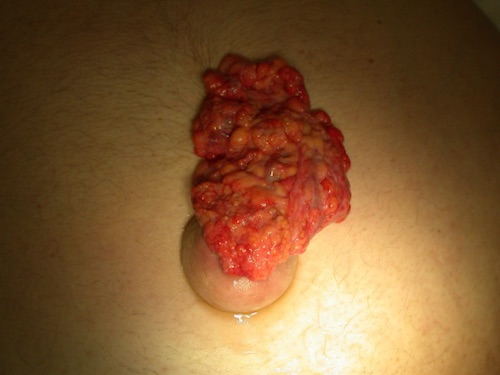Hernia with Cirrhosis
Isabella Marina Eliasson, MD
The Operative Review of Surgery. 2023; 1:228-231.
Table of Contents
Epidemiology
Incidence 1-3
- 20-40% of Patients with Decompensated Cirrhosis Have an Abdominal Wall Hernia
- Primarily Umbilical and Ventral Hernias
- Inguinal Hernias Have a Similar Prevalence to Non-Cirrhotic Patients
Contributing Factors 1
- Increased Intraabdominal Pressure from Portal Hypertension and Ascites – Primary Factor
- Malnutrition
- Subsequent Muscle Wasting and Sarcopenia
- Recanalization of the Umbilical Vein
Complications
Risks of Surgery 1,2,4
- High Overall Complication Rates
- 10% if Elective
- 40-50% in Emergent
- Wound Infection
- Hematoma or Seroma
- Dehiscence
- Uncontrolled Ascites Drainage Through the Surgical Site
- Peritonitis
- Hemorrhage
- Hepatic Encephalopathy
- Hepatorenal Syndrome
- High Recurrence Rate (70-75% if Ascites is Inadequately Controlled)
Risks of Expectant Management 1,2,4
- Incarceration and Strangulation – Emergency Surgery Has a Significantly Higher Mortality
- Skin Necrosis
- Skin Perforation and Evisceration
- Peritonitis
- Ascites Drainage
- “Flood Syndrome”: Ruptured Umbilical Hernia with Large Volume Ascites Results in Ascites Leakage Through the Skin Lesion 5

Ruptured Umbilical Hernia with Eviscerated Omentum and Ascites Leakage 6
Treatment
Medical Management of Ascites
- Uncomplicated Hernias are Initially Managed by Aggressive Medical Optimization Followed by Elective Repair 1,7
- Initial Treatments: 8,9
- Sodium Restriction
- Diuresis
- Paracentesis
- Nutritional Optimization
- Options if Initial Treatments Fail: 1,10
- Intermittent Paracentesis
- Transjugular Portosystemic Shunt (TIPS)
- Temporary Peritoneal Dialysis (PD) Catheter – High Risk of Bacterial Peritonitis and Should Be Avoided
- If Repaired Urgently Prior to Medical Optimization, Consider Placement of an Intraperitoneal Drain to Control Ascites Postoperatively
- “Watchful Waiting” is Generally Not Recommended – Increased Risk of Incarceration and Emergency Surgery 11-13
Timing for Elective Repair
- Exact Timing is Controversial 4,14
- If Patient is a Liver Transplant Candidate, it is Preferred to Delay Hernia Repair and Do it During the Transplant Operation 1
- Consider Elective Repair After Aggressive Medical Optimization with Control of Ascites
Indications for Emergent Repair 15,16
- Incarceration or Strangulation
- Skin Rupture
- Skin Changes Suggesting Impending Rupture
Mesh Reinforcement
- Elective Setting: Use Mesh 17,18
- Overall Considered Simple, Safe, and Effective 19
- Lower Recurrence Rate
- Higher Infection Rate but Mesh Exposure and Removal is Not Significantly Increased 20
- Urgent/Emergent Setting: Avoid Mesh Due to Increased Risk of Infection
References
- Bronswijk M, Jaekers J, Vanella G, Struyve M, Miserez M, van der Merwe S. Umbilical hernia repair in patients with cirrhosis: who, when and how to treat. Hernia. 2022 Dec;26(6):1447-1457.
- Snitkjær C, Jensen KK, Henriksen NA, Werge MP, Kimer N, Gluud LL, Christoffersen MW. Umbilical hernia repair in patients with cirrhosis: systematic review of mortality and complications. Hernia. 2022 Dec;26(6):1435-1445.
- Guo C, Liu Q, Wang Y, Li J. Umbilical Hernia Repair in Cirrhotic Patients With Ascites: A Systemic Review of Literature. Surg Laparosc Endosc Percutan Tech. 2020 Dec 16;31(3):356-362.
- McKay A, Dixon E, Bathe O, Sutherland F. Umbilical hernia repair in the presence of cirrhosis and ascites: results of a survey and review of the literature. Hernia. 2009 Oct;13(5):461-8.
- FLOOD FB. Spontaneous perforation of the umbilicus in Laennec’s cirrhosis with massive ascites. N Engl J Med. 1961;264:72–74.
- Good DW, Royds JE, Smith MJ, Neary PC, Eguare E. Umbilical hernia rupture with evisceration of omentum from massive ascites: a case report. J Med Case Rep. 2011 May 3;5:170. (License: CC BY 2.0)
- Myers SP, Kulkarni SS, Malik SM, Tevar AD, Neal MD. Hernia Management in Cirrhosis: Risk Assessment, Operative Approach, and Perioperative Care. J Surg Res. 2019 Mar;235:1-7.
- Jie B, Jiang ZM, Nolan MT, Zhu SN, Yu K, Kondrup J. Impact of preoperative nutritional support on clinical outcome in abdominal surgical patients at nutritional risk. Nutrition. 2012 Oct;28(10):1022-7.
- Aithal GP, Palaniyappan N, China L, Härmälä S, Macken L, Ryan JM, Wilkes EA, Moore K, Leithead JA, Hayes PC, O’Brien AJ, Verma S. Guidelines on the management of ascites in cirrhosis. Gut. 2021 Jan;70(1):9-29.
- Wong F. Management of refractory ascites. Clin Mol Hepatol. 2023 Jan;29(1):16-32.
- Choi SB, Hong KD, Lee JS, Han HJ, Kim WB, Song TJ, Suh SO, Kim YC, Choi SY. Management of umbilical hernia complicated with liver cirrhosis: an advocate of early and elective herniorrhaphy. Dig Liver Dis. 2011 Dec;43(12):991-5.
- Eker HH, van Ramshorst GH, de Goede B, Tilanus HW, Metselaar HJ, de Man RA, Lange JF, Kazemier G. A prospective study on elective umbilical hernia repair in patients with liver cirrhosis and ascites. Surgery. 2011 Sep;150(3):542-6.
- Saleh F, Okrainec A, Cleary SP, Jackson TD. Management of umbilical hernias in patients with ascites: development of a nomogram to predict mortality. Am J Surg. 2015 Feb;209(2):302-7.
- Mahmud N, Goldberg DS, Abu-Gazala S, Lewis JD, Kaplan DE. Modeling Optimal Clinical Thresholds for Elective Abdominal Hernia Repair in Patients With Cirrhosis. JAMA Netw Open. 2022 Sep 1;5(9):e2231601.
- Lemmer JH, Strodel WE, Knol JA, Eckhauser FE. Management of spontaneous umbilical hernia disruption in the cirrhotic patient. Ann Surg. 1983 Jul;198(1):30-4.
- Runyon BA, Juler GL. Natural history of repaired umbilical hernias in patients with and without ascites. Am J G
- Youssef YF, El Ghannam M. Mesh repair of non-complicated umbilical hernia in ascitic patients with liver cirrhosis. J Egypt Soc Parasitol. 2007 Dec;37(3 Suppl):1189-97.
- Hassan AM, Salama AF, Hamdy H, Elsebae MM, Abdelaziz AM, Elzayat WA. Outcome of sublay mesh repair in non-complicated umbilical hernia with liver cirrhosis and ascites. Int J Surg. 2014;12(2):181-5.
- Coelho JC, Claus CM, Campos AC, Costa MA, Blum C. Umbilical hernia in patients with liver cirrhosis: A surgical challenge. World J Gastrointest Surg. 2016 Jul 27;8(7):476-82.
- Chatzizacharias NA, Bradley JA, Harper S, Butler A, Jah A, Huguet E, Praseedom RK, Allison M, Gibbs P. Successful surgical management of ruptured umbilical hernias in cirrhotic patients. World J Gastroenterol. 2015;21:3109–3113.